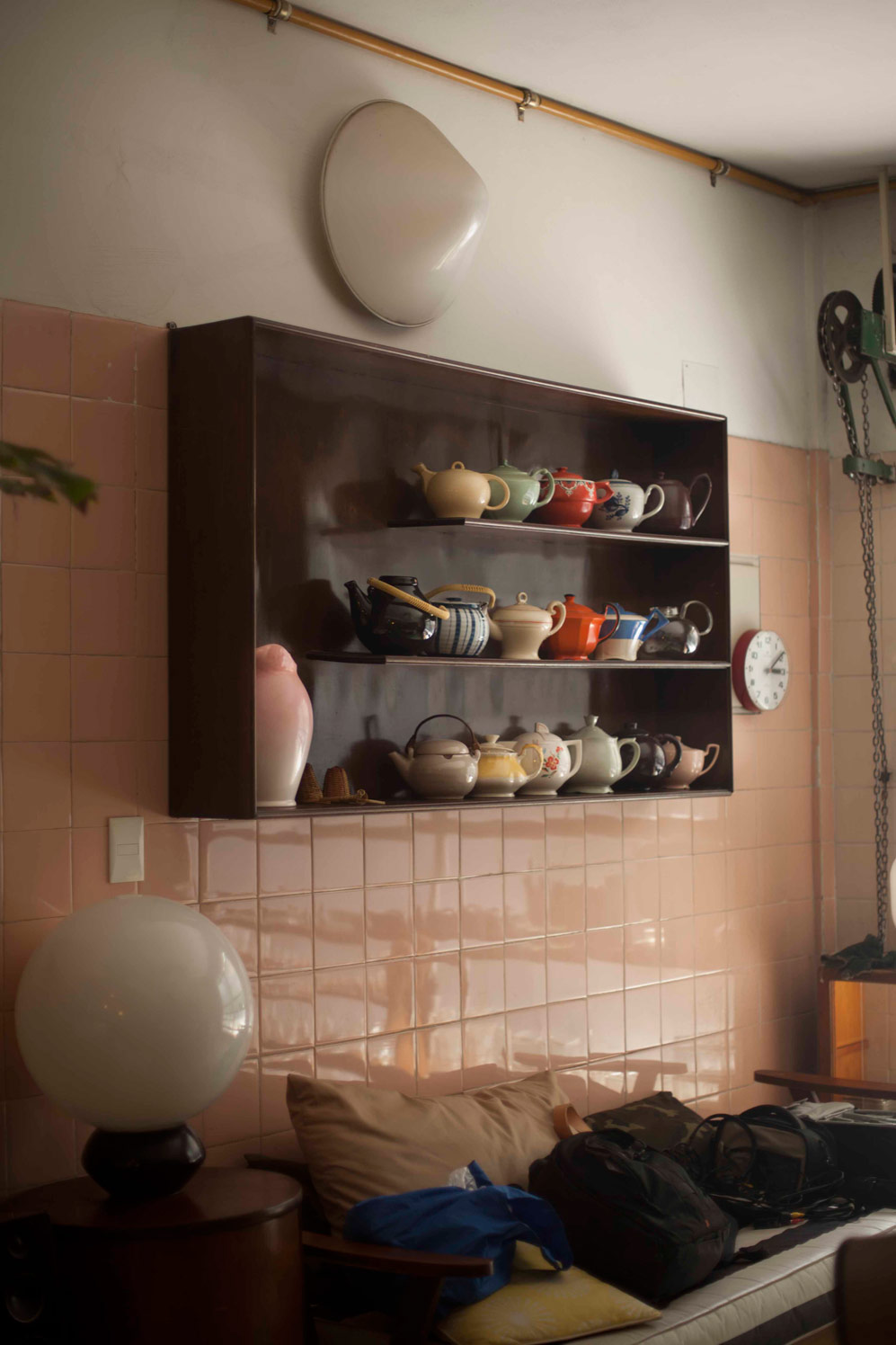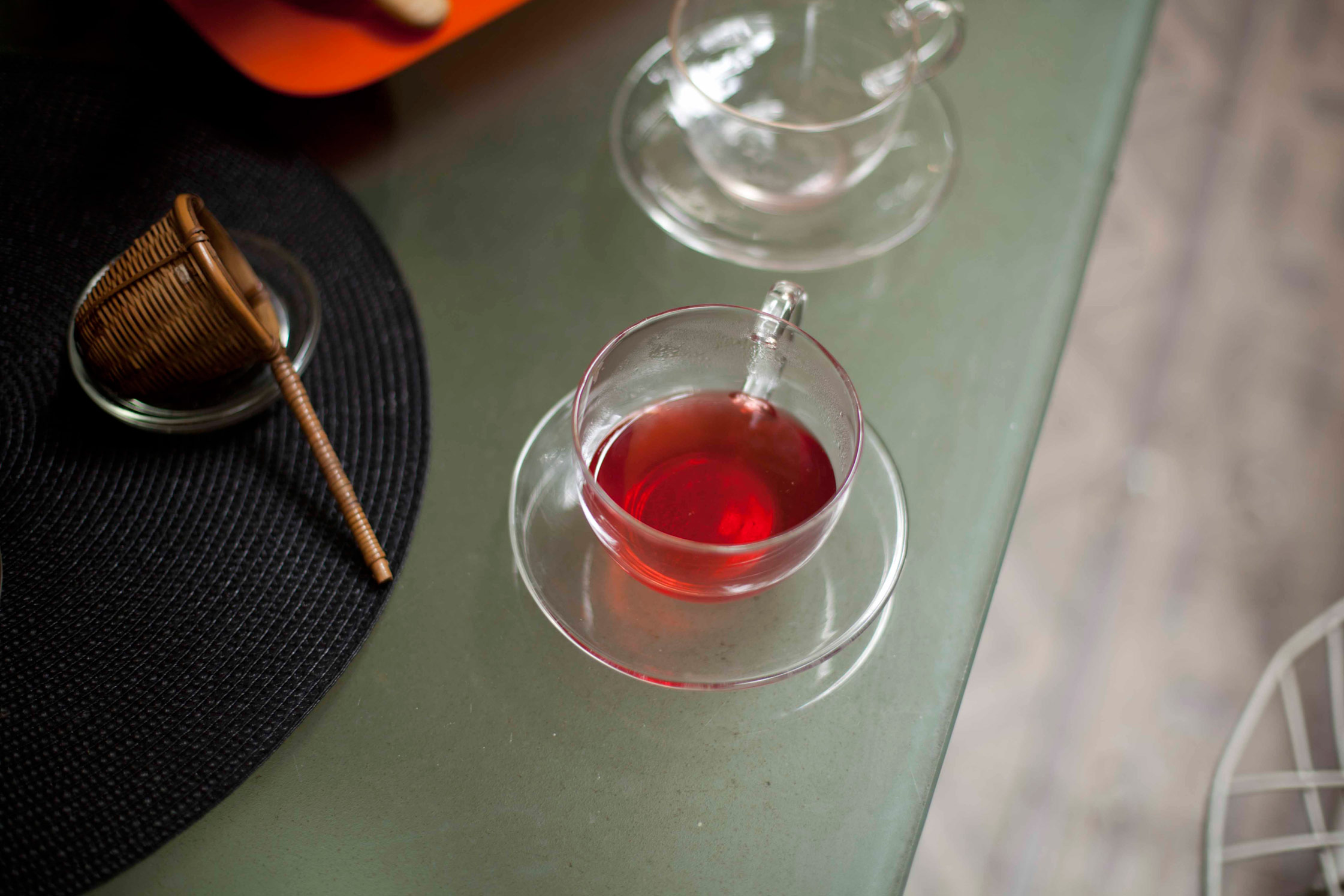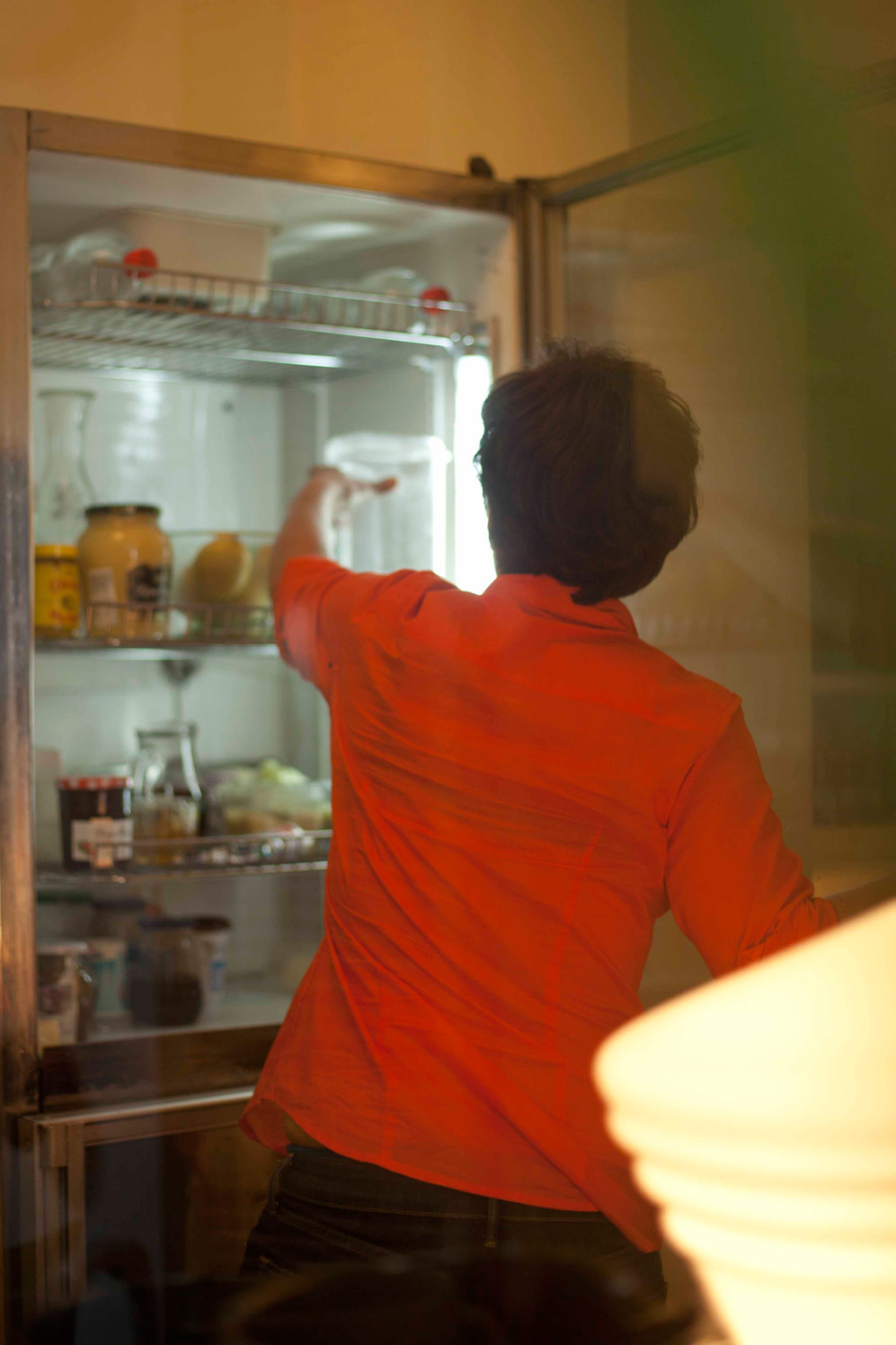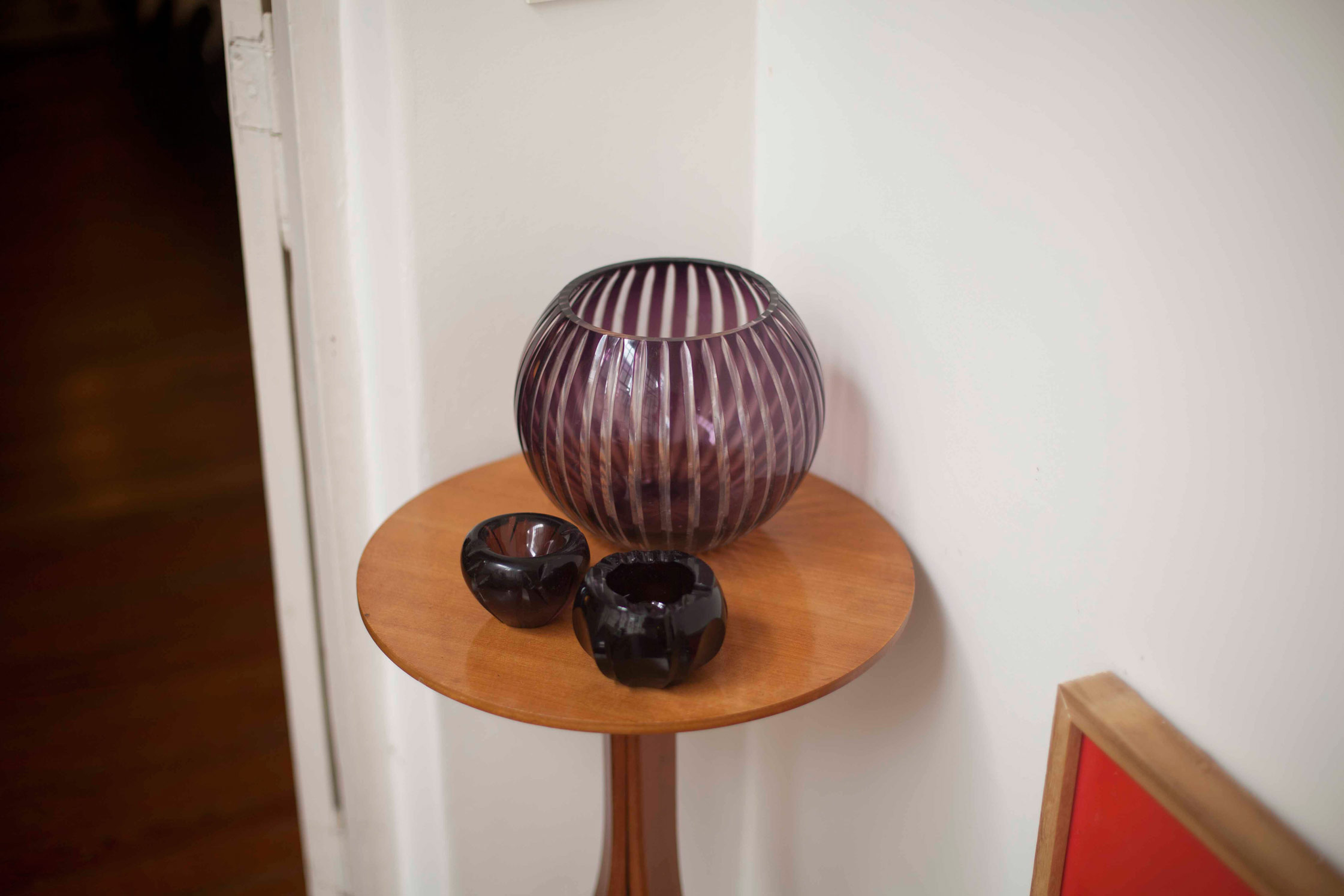If being a set designer for your own life was a job, Marcia Krygier would be an industry hotshot. Setting foot in her house in Belgrano compares to entering a theater featuring a very special show, where she plays the main character and all secondary roles while creating wonderful backdrops on- the-go. Guiding us through the various stages of her fascinating life, she discusses her disappointment with studying architecture, her brief stint in the New York gastro scene and her role as a private chef for a wealthy family, to the pleasure she takes in teaching people the magic of cooking and sharing a meal.Her huge collection of tableware and household props make sure there’s always something to choose from to create exactly the mood she envisions. It’s no coincidence that the orange, blue and black tones in her outfit are perfectly mirrored in the table set to serve tea – which incidentally is blood orange-flavored. It is safe to say that everything Marcia owns is beautiful, while her extraordinary sense of composition takes the single items to a whole new dimension. The second act takes place in her studio space in Colegiales. It becomes operatic when Marcia suddenly turns on a powerful and dramatic singing voice, but does so with seemingly effortless ease. A minute later, she slips into her cooking apron and turns into a chef while making lunch and chatting away. What remains after this extraordinary day is the certainty that the connecting thread of Marcia’s different characters, from the stylist to the chef, is extremely good taste.

































Tell us about your career path. You studied architecture, and now you’re a chef and teach cooking classes in your own studio. What made you change course?
My parents were psychologists, and I was about to study psychology too, but I had the feeling that the world of words has something elusive that didn’t do me any good. At the time of making a decision, architecture emerged as a career more related to the material world. I felt that I clung to something very solid. While studying I never actually thought about what the job of an architect really consisted of, I was unaware of how my daily work life was going to be. So when I finished I had a big disappointment. What I began to feel was that, ultimately, the life of an architect had much more to do with the thought and with having things done than with actually making them yourself. Shortly after finishing I was offered a job as a wardrobe assistant, and at that time I was very involved with sewing, so I accepted. Meanwhile I started cooking in a massive way. I would come home extremely enthusiastic about cooking, invite friends over and prepare disproportionate amounts of food. It coincided with a time when my partner was going to do a Master’s degree in New York, so I decided to go with him and study culinary arts. From that moment on, cooking became the center.
Going back to your childhood, what are your earliest memories related to cooking? Did someone in your family actually teach you? What was it that sparked your interest in the culinary field?
We used to eat very well at home. There was a kind of worship toward food. My Dad had bought a smoker and put it in the garden, and we smoked things for celebrations, giving food a special place in general. I started by baking cakes for my brother’s birthdays and bread for the end of year holidays. My Mom cooked a lot, but nobody taught me directly. I had my grandmother’s notebooks full of magazine cut-outs, so that’s where I pulled some recipes from when I was about twelve. At the time when I finished architecture, a worldwide cooking boom started, and I used to watch cooking shows on Discovery Channel until four in the morning, writing down recipes. That’s when I realized that something was happening to me, because at times I would start crying while watching the shows. I still keep a lot of folders from that time, when I cut out and wrote down and collected. I had a lot of material. But it was still a very hard, lengthy and painful process until I came to realize that I wanted to dedicate myself to cooking. Until then I had never really thought of it as a profession.
How did you end up finding your place in the culinary world? What were your experiences during your time in New York?
What I discovered when I studied culinary arts was that all professions can be performed in a way where you’re only a small part of the process, and in another one that is much more related to making something personally. With cooking it was a long road, after finishing culinary school I worked in restaurants and suffered a lot being part of a chain, but at the same time I discovered that I was much more willing to do even the dullest tasks. I was quite happy washing vegetables, peeling onions and being involved with tactile things. Afterwards I worked as a private chef for an American family, and that was a very powerful experience. It was quite an interesting combination, because they were very wealthy and very simple at the same time. They were simply exhausted of eating out, and what they wanted was the experience of eating well, but at home. I made them very thought-out, elaborate things, cooking with a lot of enjoyment and making something different every day. The job was quite similar to a scholarship, because they gave me total freedom and placed themselves in my hands completely.
Having to think of a different menu for each day is the opposite of what happens in a restaurant, where the same things are made over and over, perfecting the dishes over time. Instead, I decided on the menu asking myself: What’s the weather like today? What produce will I find? When I returned to Buenos Aires I started teaching cooking classes, both in the spirit of teaching and of taking my students through the process of making and sharing a menu. Regarding architecture, in the kitchen the distance between thought, desire, doing and seeing is much shortened. The process of grabbing an ingredient, cooking it, eating and feeling it is very impressive. The circle gets closed significantly faster.
It’s remarkable how many different professions you’ve had – aside from studying architecture and culinary arts, you have worked as a set and costume designer, as a jeweler and lately as a singer. How did you get into to these jobs? Were the transitions premeditated or spontaneous?
I come from a very informal family. My parents went through many jobs besides psychology. My Mom was a graphic designer, although originally she was a painter and ended up taking photographs and making jewelry. And my father got a grant to study film in Berlin at one point. One of my brothers is a musician and the other one is a filmmaker and an artist, I was the only one who decided to study. I was raised with a very strong presence of desire. We lived a life very intertwined with making, but in a very natural way.
My house was like that as well, we moved into a large house built in 1902, and my Dad remodeled it with us inside. It was under construction for twelve years, and we were living in the midst of dust and mess. Sometimes my brother would eat with the painter, and I remember having a stress attack when I was nine because I wanted my room to be finished eventually. But the truth is that it was very stimulating. My parents were studying jewelry with a jeweler who at one point had to leave the country, so my Dad told him: I’ll buy your whole workshop. And then the boxes arrived, full of pearl buttons, tiny metal colanders and washers. All those things went straight to the attic, so I used to go up there as if it was a different neighborhood and start putting things together. Even today I still keep a lot of buttons from that time. I have the feeling that it was an upbringing where the idea was that one kept on doing; the day was made to create.
With singing it was a similar thing. My two brothers made music, my brother Axel would take over the upstairs living room and play the piano, the transverse flute and the piccolo, and my other brother Ruy played drums, he had a band and rehearsed in the utility room. The house was full of noise, in a good way, and there were a lot of acoustics. My brothers distributed the instruments between them, but I had always liked the voice, feeling it and playing with it. Not so much in a figurative way, but using it as an instrument. At one point Axel was making a record and he suggested that I sing in one of the pieces, and I ended up recording a song that gives the album its title, Zorzal. That’s how things arose, quite naturally.
When it comes to describing you, it is unavoidable to mention that you are a huge collector of objects. However, at first glance these collections could be overlooked as they are integrated within your daily life and are not objects typically associated with collecting. Where does this passion and dedication for hunting and gathering things originate from?
I am greatly fascinated by objects of daily use and have always associated beauty with everyday things. My mother used to paint, so we were very much in contact with art. But I was always more intrigued by objects like cups or dishcloths rather than paintings. For me, collections of things relate to something vital, they are not something still, but active. Generally, I like things that are actually used. My collections are like little worlds: I have the world of dishware, which is the most developed one, the world of vases, I have a collection of dices, of necklaces, of beads, watches, handkerchieves… And all of them keep growing. My mother used to collect stationery, so I own a lot of envelopes, stickers, origami papers and little picture cards.
Also since I was as a young girl I’ve had a need for beauty as something constant. I enjoy visual things in such a huge way, and even though sometimes it can be overwhelming, I almost always consider it to be a sort of gift. Right now, as I am talking to you, I am looking at the gleam of this cup, at how the flower combines with the black, at the proximity of things. It is as if the visual union of these objects at this moment redefined them. This is immensely stimulating to me, which is also why most of my furniture incorporates glass, as it provides a look into what’s inside. I am very interested in the duality between actual usage and visual use.
Where do you find these objects? I understand that some of them were inherited and hold a history. But what about the rest? Where do you go to look for objects to fit into your collections? Antique stores, markets, the internet?
There has always been a tendency to hoard things within my family. We lived in a very big house, and there were always a lot things around. I had a phase during which I would go to the market every weekend, and it would be like instant love when I discovered something I liked. I remember exactly where and when I found certain objects, what sort of light was falling on it. For me, the object rapidly gets charged with the emotion of having discovered it. What I don’t like are places that solely have beautiful things, where the editing has already been done. I need some sort of discovery, to find an object among others, to be the one who finds it. I never buy things off the internet as I am very tactile. It wouldn’t be fun. I really like the physical feeling of looking for things.
Coming back to the gastronomy topic – on many levels we’re experiencing a trend toward home cooked meals and ‘slow food’. The number of food blogs written by amateurs is growing exponentially and the act of cooking is being celebrated almost as much as actual eating. What do you think of this development? Are your cooking classes in some way an answer to this more ‘hands-on’ approach to food?
When I finally decided to cook professionally it was a very strange decision, because at that moment cooking wasn’t anything like it is now, where one knows about the many ways there are to approach it. Yes, food is one of the most basic things in life, and the fact that it is so present and indispensable makes it magical. Besides that, it is a great opportunity to turn something that might not have any presence into something very important. It is great that new ways of understanding cooking are being considered and that people reflect more upon their personal taste.
I hate restaurants and sitting down to eat in a public space. I think that the act of eating is something much more interesting when it is done in private, like eating something while standing in your own kitchen, or laying in bed. What I have seen in my classes is that there is a gradual crescendo in the act of cooking, adding spices, seeing how it tastes, and finally eating it. There is an excitement within the process, including the tools that were used and the steps you followed. When you start kneading something, touch the ingredients, feel the dough. It’s something irreplaceable. And for me, this experience is far better than going out and eating something that was just brought to your table.
How did you end up in the studio where you teach your classes nowadays?
It was somewhat amazing to find that place. After having given classes at my old house for many years, I started to look for a place that was like a big kitchen, but everything I found required a lot of work. Originally I wasn’t looking for a street-level space, but as a matter of fact this place is semi-public, people come in often asking if I sell glasses. They are quite intrigued by not being able to look inside properly and press their noses against the glass.
What was this place’s function before you started renting it?
First it was a garage, then it was a place with a kiln to make ceramics, and afterwards it served as the neighborhood butcher shop. It was great to find a place that already had so many interesting elements and the flexibility to add new things to it. It was the equivalent to a white space, even though the tiles were pink and the floor was green. For quite a while I felt like a movie heroine every time I lifted the rolling curtains.
You mentioned before that you dislike eating in restaurants, and that you barely cook at home. Did the fact that you decided to pursue cooking professionally change your relationship with food in some way?
I’ve always had a special and intense relationship with food. When I started cooking more, a big division between the moment of eating and the moment of cooking was created. I spend a lot of my time thinking about food, tastes, combinations, menus, but it’s completely disassociated from the moment of eating. When I eat, I need things to be very plain and simple, and for the ingredients to be separated. I never eat the things that I cook, besides a slice of bread if we make a loaf. In a way I am excused because I try everything several times. It’s a procedure where you look for the moment the food grabs you and makes you experience something while you are eating it. When I finally arrive at that point, I don’t feel like eating anymore. I’ve also become more appreciative of ingredients in their natural state – I like potatoes, bread, pasta. I take a lot of pleasure in eating a high quality ingredient cooked in a simple manner, without seasoning.
And how do your students react to the fact that you don’t eat the food you make with them? I imagine it could create some kind of controversy.
It causes intrigue, and some mistrust among my students. The first three classes are always about why I don’t eat with them. It happened just yesterday. We made a butter with cilantro, chilli and lime, and put it on corn cobs. They couldn’t believe that I didn’t want to eat it. But I cannot explain how enthusiastic I was while making it. Regardless of that, I am happy thinking about food and cooking.
Besides being self-employed, do you have a daily routine? What is a typical day for you?
Starting the day backwards, after teaching the class I go home around eleven thirty. I eat chocolate and go to bed. For me, the morning is a moment ruled only by what I want to do. It’s kind of the opposite of what happens to other people. When I’m alone, I have the terrible habit of having breakfast in bed. I’ve done it since I was little, even when I have to get up really early to go somewhere. Afterwards I take an hour-long walk, it’s one of the foundations of my daily life. When I’m back I run a couple of errands, and depending whether I have an event that day, I go home and cook. If not, I start gathering things for my class, I drive to the studio and start preparing everything. When the students arrive, the most active part of the day begins, which is at night time.
My routine is always changing, though. Since I cook a different menu every day, a big part is dedicated to thinking about the ingredients, the seasons. I essentially give myself the space to make whatever I feel like each day, because I believe that’s how things turn out best. I decide based on what ingredient is tempting me or if the climate dictates certain foods. If it is cold, I think of a red wine stew with sweet potato gnocchis and mushrooms. And there are days for making lighter things. I also need to be in the mood for cooking whatever it is we are making. This is very important to me, because it guarantees a great result. Yesterday I made a mistake. I shouldn’t have planned such an arduous menu, and in the middle of the class I realised that I wasn’t in the mood to cook what I had designed myself. But those are the problems and the great things about having a job that provides room for something temperamental. I think having that possibility is incredible.
Thank you very much for your time and the delicious food, Marcia!
Interview & Text: Julia Keller
Video & Photography: Carolina Colmenero / Küche
Edit: Santiago Parysow
Sound Post-Production: Sofia Straface
Producer: Freunde von Freunden
